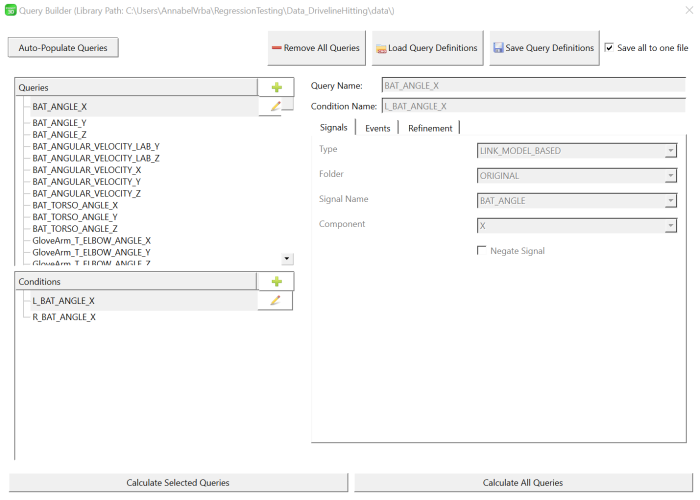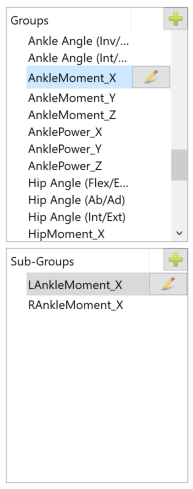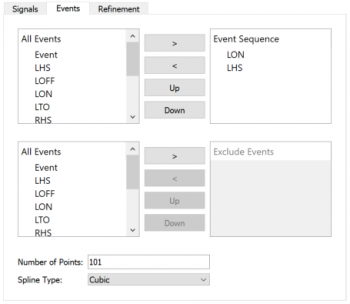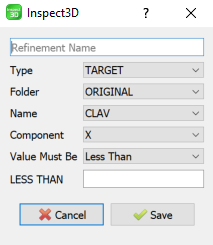Inspect3D Advanced Query Section: Difference between revisions
(Updated all references to Group/Sub-Group to Query/Condition.) |
|||
| (19 intermediate revisions by 3 users not shown) | |||
| Line 6: | Line 6: | ||
The Query Builder dialog is used to define the queries that will extract signals from the loaded CMZ library. The dialog also allows you to group specific signals together based on a number of possible features, e.g. right/left or intact/affected. | |||
[[Image:querybuilder.png|700 px]] | |||
==Auto-Populate Queries== | |||
Inspect3D has the convenient ability to automatically define queries based on common signals and groupings. This feature saves the user from the tedious task of manually defining common queries. More information about Auto-Populating Groups can be found [[Inspect3D:_AutoPopulate_Groups|here]]. | |||
== | ==Query Definition File== | ||
[[Image:I3DAdvancedQueriesDialogueLoadSave.png]] | [[Image:I3DAdvancedQueriesDialogueLoadSave.png]] | ||
Inspect3D also allows users to save time by saving queries definitions to a [[Q3D Query File|.q3d file]] so that they can be easily re-used during future analysis. This capability is at its most useful when using the Load Group Def & Compute Groups option in the Group Definitions drop-down menu. | |||
== | ==Queries and Conditions== | ||
{| style= width="100%" | |||
| style="width: 50%" align="left" style="vertical-align:top"| | |||
You can define Groups and Sub-Groups for the signals in the CMZ library. | |||
* An example <b>Group</b> is "AnkleMoment_X" | |||
* Example <b>Sub-Groups</b> for "AnkleMoment_X" are "LAnkleMoment_X" and "RAnkleMoment_X" | |||
* A group can have as many Sub-Groups as necessary (1-N) | |||
Names for Queries and Conditions can include spaces and special characters. Note, however, that some special characters can cause difficulty for updating CMZ libraries with exclusions. Condition names can be repeated between different queries but not within a single query. | |||
| style= "width: 50%" align="right" style="vertical-align:top"| | |||
[[Image:I3DAdvancedQueriesDialogueQueryName2.png|right]] | |||
|} | |||
==Condition Definition== | |||
The Condition Definition lets you define the signals you want to query. Query results are defined according to the signals you want from the CMZ library, the events or event sequences to which you want to time normalize the signals, and any further refinements that you want to apply, e.g., threshold values. | |||
===Signals=== | |||
{| style= width="100%" | |||
| style="width: 50%" align="left" style="vertical-align:top"| | |||
[[File:I3D_GroupDef_Signals.png|350px]] | |||
[[ | | style= "width: 50%" align="left" style="vertical-align:top"| | ||
This tab allows the user to select a signal according to how it is specified in the [[Data_Tree_Summary|Visual3D Data Tree]]. This specification includes four components with an additional option to negate the results. | |||
* Type | |||
* Folder | |||
* Name | |||
* Component | |||
* Negate Results | |||
|} | |||
===Events=== | ===Events=== | ||
{| style= width="100%" | |||
| style="width: 50%" align="left" style="vertical-align:top"| | |||
[[File:I3D_GroupDef_Events.png|350px]] | |||
| style= "width: 50%" align="left" style="vertical-align:top"| | |||
This tab allows user to specify the events to which the data will be normalized, which event sequences should be excluded, and how the data should be normalized. | |||
[[ | * <b>Event Sequence:</b> Events to normalize data to | ||
** Typically Kinematic Signals are normalized from R/LHS to R/LHS | |||
** Typically Kinetic Signals are normalized from R/LON to R/LHS | |||
* <b>Exclude Events:</b> | |||
** Event sequences that data should not be included | |||
* <b>Number of Points:</b> Typically a gait cycle is normalized to 101 data points | |||
* <b>Spline Type:</b> Cubic or Linear - you should use a cubic spline to normalize the data | |||
|} | |||
</ | |||
< | |||
</ | |||
< | |||
< | |||
< | |||
</ | |||
===Refinement=== | ===Refinement=== | ||
{| style= width="100%" | |||
| style="width: 50%" align="left" style="vertical-align:top"| | |||
[[File:I3D_GroupDef_Refinement.png|350px]] | |||
| style= "width: 50%" align="left" style="vertical-align:top"| | |||
This tab permits signal selection to be refined according to additional conditions that must be met. There are two broad types of refinements: | |||
[[ | * <b>Refine using tag:</b> Any tags that exist in the workspace can be selected | ||
** <b>Use AND Logic:</b> Determines how to treat refinements based on more than one tag. If checked, then the query will only include trials that contain ALL of the selected tags. If unchecked then the query will include trials that contain ANY of the selected tags. | |||
< | |} | ||
< | |||
<br> | <br> | ||
<br> | <br> | ||
{| style= width="100%" | |||
| style="width: 50%" align="left" style="vertical-align:top"| | |||
* <b>Refine using signal:</b> These refinements allow users to specify additional criteria that must be met before a signal in brought into the group you define. These criteria are defined using the following information: | |||
< | ** <b>Refinement Name:</b> Each refinement in a sub-group requires a unique name | ||
< | ** <b>Signal Definition:</b> Specify the signal you want to work with as it is referenced in the [[Data_Tree_Summary|Visual3D Data Tree]], i.e., Type, Folder, Name, and Component. | ||
** <b>Value Must Be:</b> There are 6 types of criteria that can be specified for a refinement. | |||
*** <b>Less Than</b>: The signal must be less than the specified threshold to be included | |||
*** <b>Greater Than</b>: The signal must be greater than the specified threshold to be included | |||
*** <b>Equal To</b>: The signal must be equal to the specified threshold to be included | |||
*** <b>Not Equal To</b>: The signal must not be equal to the specified threshold to be included | |||
*** <b>Between</b>: The signal must be between the two specified values to be included | |||
*** <b>Manual</b>: The signal must satisfy the specified [[Expressions|Visual3D Expression]] | |||
| style= "width: 50%" align="left" style="vertical-align:top"| | |||
[[File:I3D_GroupDef_RefinementDialog.png|250px]] | |||
|} | |||
< | |||
</ | |||
< | |||
</ | |||
== | |||
[[ | |||
[[Category:Inspect3D]] | [[Category:Inspect3D]] | ||
Latest revision as of 17:12, 19 October 2023
| Language: | English • français • italiano • português • español |
|---|
The Query Builder dialog is used to define the queries that will extract signals from the loaded CMZ library. The dialog also allows you to group specific signals together based on a number of possible features, e.g. right/left or intact/affected.
Auto-Populate Queries
Inspect3D has the convenient ability to automatically define queries based on common signals and groupings. This feature saves the user from the tedious task of manually defining common queries. More information about Auto-Populating Groups can be found here.
Query Definition File
Inspect3D also allows users to save time by saving queries definitions to a .q3d file so that they can be easily re-used during future analysis. This capability is at its most useful when using the Load Group Def & Compute Groups option in the Group Definitions drop-down menu.
Queries and Conditions
Condition Definition
The Condition Definition lets you define the signals you want to query. Query results are defined according to the signals you want from the CMZ library, the events or event sequences to which you want to time normalize the signals, and any further refinements that you want to apply, e.g., threshold values.
Signals
|
This tab allows the user to select a signal according to how it is specified in the Visual3D Data Tree. This specification includes four components with an additional option to negate the results.
|
Events
|
This tab allows user to specify the events to which the data will be normalized, which event sequences should be excluded, and how the data should be normalized.
|
Refinement
|
This tab permits signal selection to be refined according to additional conditions that must be met. There are two broad types of refinements:
|
|





